
The Sustainable and Smart Mobility Strategy places the European rail transport in an important position due to its ability to decarbonise the transport system and create digital networks and services. The development potential of the railway needs to be exploited to the full to ensure the takeover of road traffic and increase the share of rail transport compared to other modes because it already proves its advantages: it is the most sustainable mode of transport, it has managed to reduce the level of greenhouse gas emissions and it is the most electrified mode of transport. The implementation of the new strategy may make rail transport the first choice in both segments – freight and passenger, but significant efforts are required to achieve the goals of doubling freight and high-speed traffic.
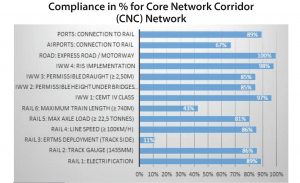
At the European Union level, two major transport networks will form an efficient, fast and sustainable system by 2050. The TEN-T Core Network will have to be completed by 2030, encompassing the most important connections between the main transport hubs, and the Comprehensive Network, which will cover all European regions by 2050, forming the links necessary for a high-performance transport system that will provide the necessary capacity, as well as quality and digitalised services across the EU territory.
The main artery of the Core Network is characterised by the nine corridors, and two horizontal priorities – ERTMS and Motorways of the Sea will complete the efficient operation of the network. Core Network includes about 67,000 km of railway lines, of which for 8,500 km are projects for new constructions or significant upgrades. It is important to mention that the revision of the TEN-T Regulation will be presented next year.
The Progress Report on the implementation of the TEN-T Network, which was published in August 2020 and included an analysis for the period 2016-2017, shows that the implementation of the Core Network Corridors is between 81 and 100% for 10 of the 13 TEN-T Regulation requirements, and in the case of the three requirements, compliance rates are between 11 and 67%. Moreover, 89% of seaports are connected to the railway network, while 67% of airports have a railway connection.
One of the main requirements of the network, on the railway segment, is the electrification of the rail, whose compliance has reached 89%, moreover, compliance in terms of track gauge is at 86%, in terms of freight line speed it is also 86%, whereas in terms of freight axle load it is 81%.
According to the Eighth Annual Market Monitoring Report published in 2020 by the IRG-Rail, 55% of the total route length (234,037 km is the total route length) is electrified. The largest increases in the length of electrified route since 2017 were recorded in the United Kingdom, Greece and Poland.
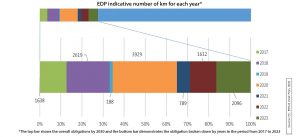
ERTMS deployment is 11%, still lagging far behind the objectives for the creation of a digitised railway system that would enable the formation of the Single European Rail Area. According to the ERTMS report of May 2020 by Coordinator Matthias Ruete, in April 2020, ETCS was in operation on 12% of the Core Network Corridor (CNC), representing 6,120 km, and 63% of the network was operating with GSM-R. Of the total length of 15,682 km to be put into operation in 2023 according to the European Deployment Plan, only 38% (namely 5,906 km) was put into operation and 78% of the EDP planning for 2019 was completed. ERTMS deployment and operation are in different stages and percentages for each corridor taken separately.
Clearly, the various reports and estimates show that significant efforts need to be made for the European Union’s rail network to achieve its goals. European policy for the coming decades focuses on creating a climate-neutral continent by 2050, when the entire EU economy and activity will operate with net zero greenhouse gas emissions. What is certain is that each economic sector must lower its emissions and that the transport segment remains a major source with a negative impact on the environment, since it is responsible for 27% of the total greenhouse gas emissions in the EU. Of all modes of transport, the road is the largest emitter, causing 72% of the GHG emitted by the entire system. If no action is taken to rectify the situation, emissions from the transport sector will increase by 32% by 2030, compared to the 1990 levels. As a result, it is necessary to provide for new measures, plans and actions with the aim of achieving the objectives set by the European Green Deal, which resets the European Commission’s commitment to addressing climate and environmental challenges. On the transport segment, the new EU approach aims to rethink policies to accelerate the shift of traffic to sustainable transport modes and the creation of a smart system.
In order to achieve climate neutrality by reducing 90% of transport emissions by 2050, rail and waterborne transport are key ways to support this drastic and necessary reduction.
The European Green Deal relies on shifting traffic to rail and inland waterways, which will have to take over 75% of land freight traffic. However, this requires measures to better manage and increase the capacity of rail and inland waterway transport.
Facts and figures
The railway deserves its key role in significantly reducing emissions because it has the capacity to comply with new policies, since it is a mode of transport with already low emissions, it is the most electrified mode of transport and it has the necessary perspectives for digitisation. Emissions from rail activity, which includes only emissions from diesel trains, have halved since the 1990s, and the share of rail transport in emissions from transport is less than 1%.
The importance of rail in the transition to zero-emission and digitised mobility, with an impact on climate neutrality is underlined by the recently announced Sustainable and Smart Mobility Strategy.
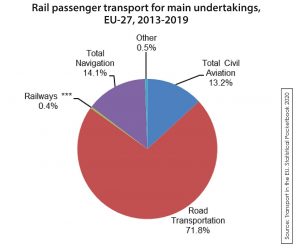
According to EC statistics published in 2020, rail freight traffic in the EU-27 was 423.3 billion tkm, up 2.1% compared to the previous year, and passenger traffic was 407.2 billion pkm (in 2017).
Eurostat analyses mention that in 2019 rail transport in passenger-kilometres was 416 billion, up 3.4% compared to 2018. The increase was influenced by the activity in the second quarter of 2019, when it resulted in an 8.7% increase compared to the similar period of the previous year, whereas there were increases of 2.9% and 4.1% in the first and third quarters respectively. The fourth quarter saw a slight increase of only 0.1%.
On the freight segment, in 2019 the traffic was 400 billion tonne-kilometres, decreasing by 2.2% compared to the previous year. The first quarter was the only one that registered increases (of 2.5%), while the remaining quarters saw decreases between 0.7% and 8.2%.
During the COVID-19 pandemic, the European rail transport faced an extreme situation, experiencing massive declines in passenger transport during the peak period, where declines reached over 90% in some European countries and many international rail connections were suspended. In the first half, the turnover dropped by 35% and improved in July and August, reaching a decrease of 28% in July 2020 compared to July 2019 and of 27% in August compared to August 2019. But figures are still far from reaching pre-crisis levels, since the second wave of the pandemic hit in September, with turnover losses of 29%.
However, rail freight traffic still operated during the pandemic, ensuring the transport and delivery of products, but it also faced decreases, nevertheless they were smaller than those experienced by other modes of transport. The impact of the pandemic led to a 15% decline in revenues in the first half of 2020, and revenue losses of EUR 1.25 billion accumulated in the first six months of 2020.
Railway infrastructure managers were faced with an unprecedented situation in a chain reaction due to the massive reduction in traffic and generated revenue. As a result, the European Commission came up with support measures to counter the adverse economic effects of the epidemic on the railway sector. Thus, a regulation was published allowing railway managers to reduce, eliminate or postpone the payment of track access charges because a hypothesis was put forward according to which operators would not be able to pay the charges. The temporary measures set out in Regulation 2020/2180 had a deadline for January 1st, but due to the pandemic, it was recently announced that the period was extended until June 30th, 2021.
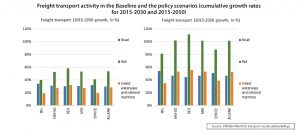
Despite all these problems facing rail transport, under existing transport policies, rail transport activity is estimated to grow much faster than freight due to the completion of the TEN-T Core Network by 2030 and the Comprehensive Network by 2050. Passenger rail transport could increase by 32% in the next decade, and the Commission expects an increase of 66% for the period 2015-2050, with its modal share increasing by 1% by 2030 and by another 1% by 2050. Freight traffic, on the other hand, will increase by 40% in 2030 and by 81% in 2015-2050, and the market share will be 1% by 2030 and 2% in 2050.
The strategy
In 2018, transport contributed 30.5% of the EU-27’s final energy consumption and was responsible for the emission of 24.6% of GHG emissions, 31.8% above 1990 levels, excluding international maritime transport, which, if included, the share of emissions from transport would reach 27.2%. GHG emissions from transport increased from 16.5% in 1990 to 27.2% in 2018, and road transport hasd a huge proportion of 71.8%, registering an increase of 26.8% in the period 1990-2018.
As long as the European Union’s objectives aim at sustainable, emission-free development, it is transport that must reduce its emissions and it cannot be done without the railway, which has huge potential to be exploited in order to support emission reductions across the transport system. The Sustainable and Smart Mobility Strategy points out precisely that, as it revolutionises transport and encourages the development of the railway system through its actions, setting ambitious objectives.
High-speed rail
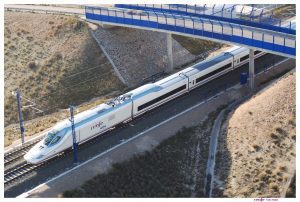
In short, by 2030, high-speed rail traffic should double, and by 2050, it should triple from 2015 levels, replacing several short-haul flights.
According to the analyses, the supply of high-speed rail services will provide passengers with an alternative to short-haul flights, and where these services may have connections to create attractive long-haul offers, this will reduce CO2 compared to short-haul flights and will free up airport capacity, avoiding the maintenance of unprofitable flight routes. But these attractive connections need investment to improve access of high-speed rails to airports.
However, not only high-speed rail infrastructure comes with an attractive offer, but also the provision of inexpensive, flexible and reliable services. Here the Fourth Railway Package has an essential role because by opening the market, any high-speed rail will be able to be operated by private companies, not only state-owned ones.
According to the latest statistics, in 2018 high-speed rail traffic increased by 1.5%, reaching 126.09 billion pkm in the EU-27. Also, the share of high-speed rail traffic in rail transport was 31%. In 2017, the high-speed network measured 9,169 km in length (for trains running at over 250 km/h). Works are currently underway to complete 25 high-speed rail projects totalling 2,059 km in five European countries – Germany, Spain, Italy, Austria and Sweden. The lines would be put into operation from 2021, 2024, and, in turn, until 2027.
Rail freight transport
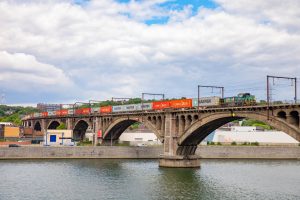
The strategy mentions that rail freight will have to increase by 50% by 2030, and it will have to double by 2050. Rail Freight Corridors Regulation is in the process of being reviewed and is essential for its attractiveness and competitiveness, including in the context of the multimodal network. There is a need to strengthen cooperation for cross-border crossings, to coordinate operations that face obstacles, especially in the legislative segment. The harmonisation of operating rules and the deployment of ERTMS will lead to cost reductions and will create new capacities to meet future but also current traffic requirements, because there are several issues that hamper the performance of rail freight traffic.
The different scenarios tackled by the Sustainable and Smart Mobility Strategy show that rail freight will increase, in the case of the baseline scenario by 9-13% in 2030 and by 11-17% in 2050 with the highest increase taken into account by regulatory-based measures scenario. This is equivalent to a 53-58% increase in rail transport in the period 2015-2030 and to an increase of 102-111% between 2015 and 2050 respectively.
During the period when high-speed rail and freight rail transport will develop significantly, electrification must be continued and where it is not viable, the share of using hydrogen-based technology should increase, since these trains, along with battery-operated trains to be introduced, enable the disposal of diesel rolling stock.
Electrification is a major option in all scenarios; the baseline scenario provides for a share of 89% for passenger rolling stock that should be operational by 2050 and 79% for freight. Electric rolling stock is expected to account for 94-95% of the entire passenger train fleet and 88-89% of the freight train fleet in 2050. Thus, the railway infrastructure must be electrified on a large scale by 2050 in order to match electric train traffic.
Moreover, hydrogen trains would have a contribution of about 1% of the rolling stock used in the case of passenger transport and about 2% in the case of freight.
Rail and the flagships
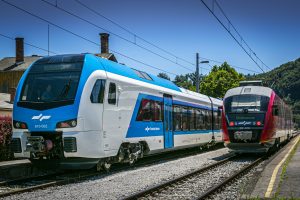
The three pillars of the strategy – sustainable, smart and resilient, are addressed through the 82 actions proposed in ten flagship initiatives.
With direct reference to rail transport, it is included in five flagships of which 3 and 4 belong to the Sustainable Mobility action plan, 6 and 7 are included in the Smart Mobility pillar and flagship 10 is part of the Resilient Mobility action plan.
Sustainable mobility:
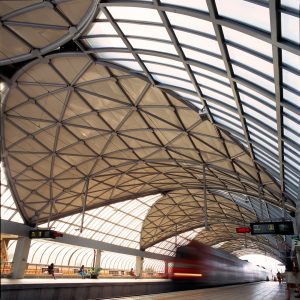
Flagship 3 mentions two initiatives that point directly to the railway. One aims at the 2021 Rail Corridor Initiative, as an action plan to stimulate rail passenger transport. Another initiative includes establishing measures for better management and coordination of international rail traffic, including the revision of rules on the allocation of necessary capacity and the track access charges. This is expected to be implemented in 2022.
Next year will be the European Year of Rail, which will provide a platform for raising awareness of the importance of the European rail transport for a clean environment and the development of cross-border connections to create an efficient and fast service system. By implementing the Fourth Railway Package and opening up the market, operators will respond to customer needs in a more efficient, qualitative and cost-effective manner. As a result of the completion of the TEN-T, which includes high-speed rails, more and faster connections will be provided. Next year, the EC will propose an action plan to stimulate cross-border and long-haul rail passenger transport services. Here, states will make a significant contribution to creating much faster connections between cities through efficient capacity management, train schedule coordination, efficient and comfortable rolling stock, and investment in infrastructure for the development of new services. Pilot services will be carried out on a series of routes that include all stakeholders and a combination of public and open access services will be formed to be able to test various models for new connections. There are plans to launch 15 such pilot projects by 2030 that will look into all types of services and combinations in order to provide efficient and seamless services.
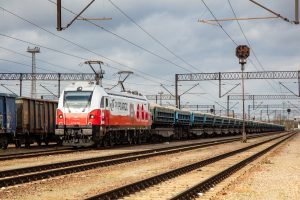
Flagship 4 includes the rail corridor initiative and aims to review the freight rail corridors regulation from 2021. With a view to meeting the goal of shifting 75% of road freight traffic to rail and inland waterways, freight rail needs increased capacity, efficient and fast cross-border connections and the implementation of digital solutions and new technologies. By reviewing the rail freight corridors regulation, their integration with the European transport corridors is sought focusing on “quick wins” including train length, loading gauge, optimisation of operational rules, alongside the construction of missing links, with infrastructure elements consolidating and promoting intermodal transport. The Commission intends to propose improved rail capacity allocation rules in line with the timetable redesign project, which will mean providing additional and flexible paths.
Smart mobility:
Flagship 6 involves the transformation of connected and automated multimodal mobility and includes the railway in two of the nine actions. One of them aims at assessing the need for measures to regulate the rights and obligations of multimodal digital service providers and to issue recommendations to ensure that public service contracts do not prevent the exchange of data and contribute to the development of multimodal travel ticketing services, alongside a ticketing initiative that also includes rail transport. The deadline for this initiative starts in 2022.
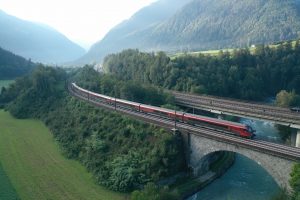
Multimodal travel planning and ticketing is currently cumbersome due to the lack of a framework regarding the existence of integrated and multimodal information, issuance and payment services. In order to solve this complex problem, account is taken of analyses as to the availability and accessibility of data that is currently insufficient, of collaboration between suppliers and sellers which must be strengthened and correlated, of the need for digital tickets and of the payment systems which must become interoperable.
The adoption of the package of technical standards and specifications for ERTMS/control-command and signalling (CCS) and the development of mandatory implementation plans for automatic train operation and automatic traffic management, but also advanced level CCS is expected also from 2022. To this end, the Commission intends to propose updating the technical specifications for interoperability, including new technologies such as 5G and ensuring a common and easily upgradeable architecture and infrastructure. The implementation of these actions will allow ERMS to become the centre of a digitised railway system, since this type of transport would lead to CO2 reduction.
Flagship 7 concerns innovation, data and artificial intelligence for smart mobility which includes two actions out of a total of 10. One of the actions includes the development or renewal of research and innovation partnerships, with an impact on connected and automated mobility. On the railway segment the Shift2Rail is concerned, but Clean Hydrogen Partnership, Smart Networks and Services, etc. are also included. In this regard, in August 2020, the European Commission issued an invitation to public and private entities interested in becoming members of the European Partnership on Rail Research and Innovation, as the successor to Shift2Rail JU. The objectives of the new partnership will be integrated with the objectives of the European Green Deal for shifting 75% of land traffic to rail and inland waterways, but also with Europe fit for the digital age. This will optimise European competitiveness and technology while maintaining the EU’s global leadership. The final purpose, objective and budget of the partnership will depend on the political agreement on the establishment regarding the Joint Undertaking as well as on the Master Plan agreement between the European Commission and the partners. The Master Plan will be prepared based on the Strategic Research and Innovation Agenda (SRIA) currently developed by ERRAC.
The core members of the Rail European Partnership will be represented by 20 entities including infrastructure manager, operators (freight, passenger and urban), rolling stock, signalling system and infrastructure manufacturers, as well as ITC solution providers and railway research centres.
The second activity of this flagship initiative, set for 2022, involves reviewing the regulatory framework for interoperable data exchange in rail transport including ERTMS and railway telematics applications.
Resilient mobility:
It has three flagships, one of which (8) aims to strengthen the single market, for which the revision of the TEN-T Regulation, which will support sustainable mobility, will be presented next year.
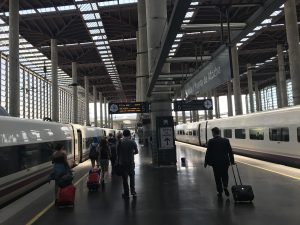 Flaghip 10 makes direct reference to “rail” and has the general purpose of improving the safety and security of European transport, which is essential and needs to be ensured in all circumstances. For this, not only the European authorities, but also the national and local authorities and the stakeholders must get involved in order to achieve zero fatalities in the transport system. In 2019, 22,700 people lost their lives on European roads, and for one person killed, approximately five other persons are injured. Among other measures and efforts to be made in transport and infrastructure, the EU intends to upgrade and optimise the existing security framework by combating cyber threats.
Flaghip 10 makes direct reference to “rail” and has the general purpose of improving the safety and security of European transport, which is essential and needs to be ensured in all circumstances. For this, not only the European authorities, but also the national and local authorities and the stakeholders must get involved in order to achieve zero fatalities in the transport system. In 2019, 22,700 people lost their lives on European roads, and for one person killed, approximately five other persons are injured. Among other measures and efforts to be made in transport and infrastructure, the EU intends to upgrade and optimise the existing security framework by combating cyber threats.
In rail transport, safety is ensured by requirements for the technical specifications of railway vehicles and infrastructure, as well as by safety management systems and tools for operators and infrastructure providers set out by the directives on railway safety and interoperability. The regulations require that the various elements of the railway system be supervised by national authorities, and authorisations for placing railway vehicles on the market and their entry into service are provided by the European Union Agency for Railways (ERA). On the European railway infrastructure, there are 0.1 deaths per billion passenger km, although they differ between Member States. The EC, ERA and states work together to maintain this level of safety and increase the level of safety where necessary. The actions include the promotion of a culture of railway safety, and its level will increase through the implementation of new versions of signalling and train protection systems, with the ERTMS ensuring safe traffic.
The action mentioned in Flaghip 10 includes optimising the safety of rail passenger transport by implementing the results of the rail safety action plan and the Platform for the safety of rail passengers.
Share on:



